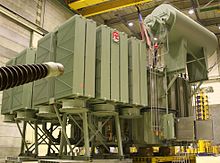
A phase angle regulating transformer, phase angle regulator (PAR, American usage), phase-shifting transformer, phase shifter (West coast American usage), or quadrature booster (quad booster, British usage), is a specialised form of transformer used to control the flow of real power on three-phase electric transmission networks.
For an alternating current transmission line, power flow through the line is proportional to the sine of the difference in the phase angle of the voltage between the transmitting end and the receiving end of the line.[1] Where parallel circuits with different capacities exist between two points in a transmission grid (for example, an overhead line and an underground cable), direct manipulation of the phase angle allows control of the division of power flow between the paths, preventing overload.[2] Quadrature boosters thus provide a means of relieving overloads on heavily laden circuits and re-routing power via more favorable paths.
Alternately, where an interchange partner is intentionally causing significant "inadvertent energy" to flow through an unwilling interchange partner's system, the unwilling partner may threaten to install a phase shifter to prevent such "inadvertent energy", with the unwilling partner's tactical objective being the improvement of its own system's stability at the expense of the other system's stability.[original research?] As power system stability—hence reliability—is really a regional or national strategic objective, the threat to install a phase shifter is usually sufficient to cause the offending system to implement the required changes to its own system to greatly reduce or eliminate the "inadvertent energy" flowing through the offended system.
The capital cost of a quadrature booster can be high: as much as four to six million GBP (6–9 million USD) for a unit rated over 2 GVA. However, the utility to transmission system operators in flexibility and speed of operation, and, more particularly, facilitating economic dispatch of generation, can soon recover the cost of ownership.
- ^ The "equal area criteria" for power system stability requires that this angle be less than 90 degrees, so for practical purposes this angle will be measurably less than 90 degrees.
- ^ Weedy, B. M. (1972), Electric Power Systems (Second ed.), London: John Wiley and Sons, pp. 127–128, ISBN 978-0-471-92445-6